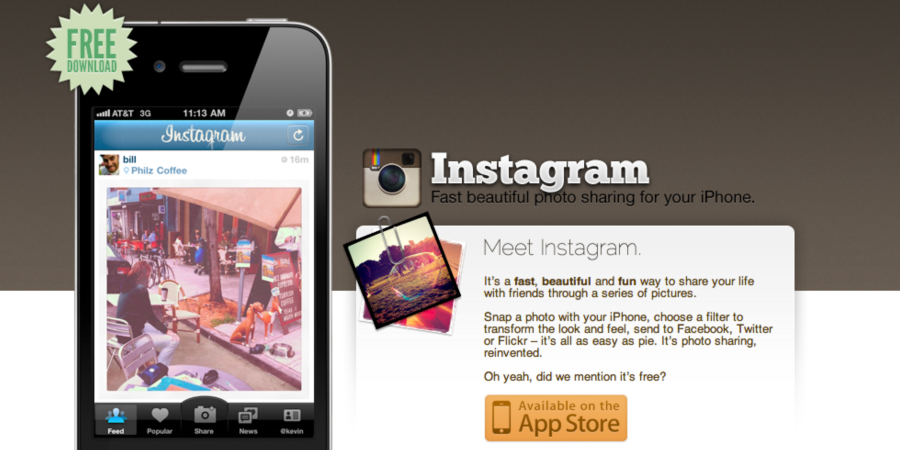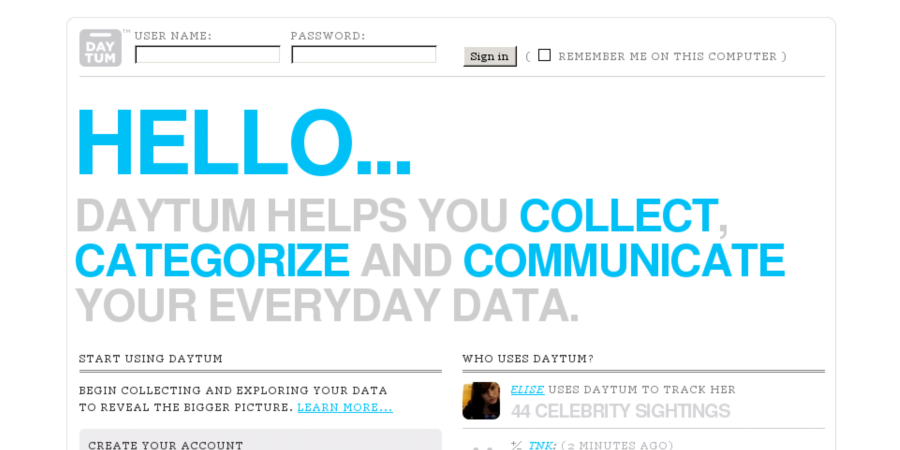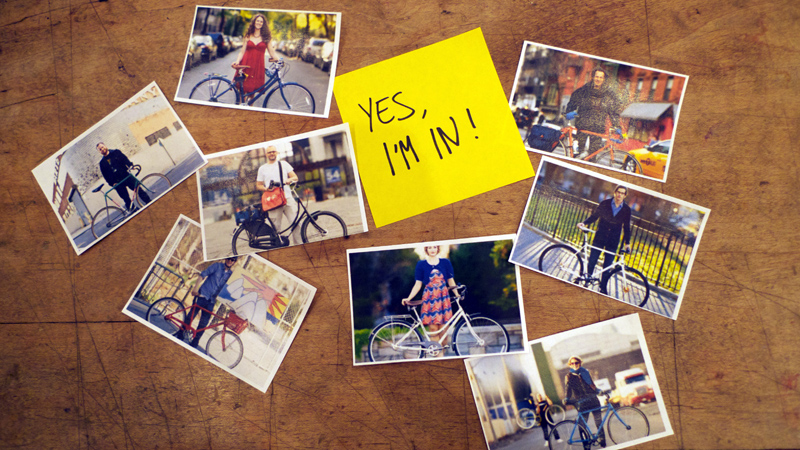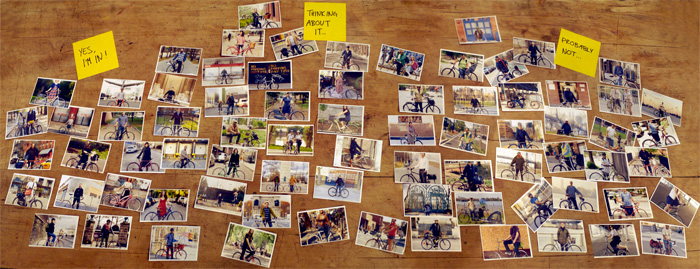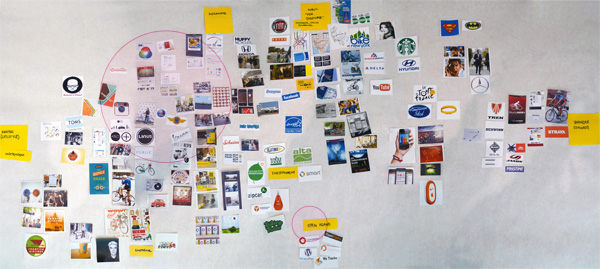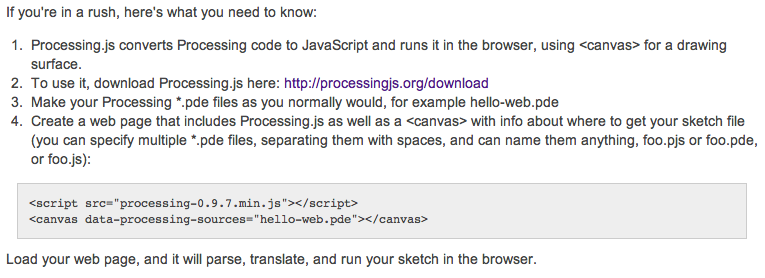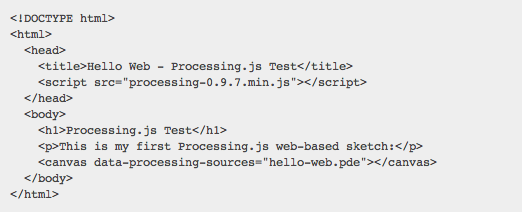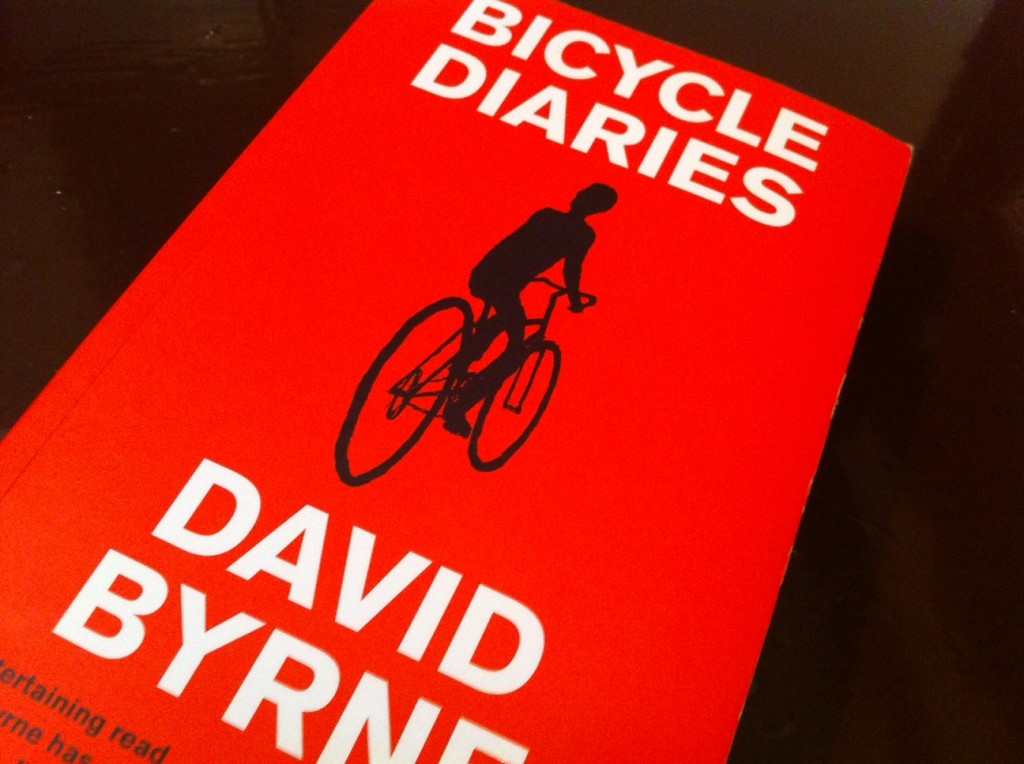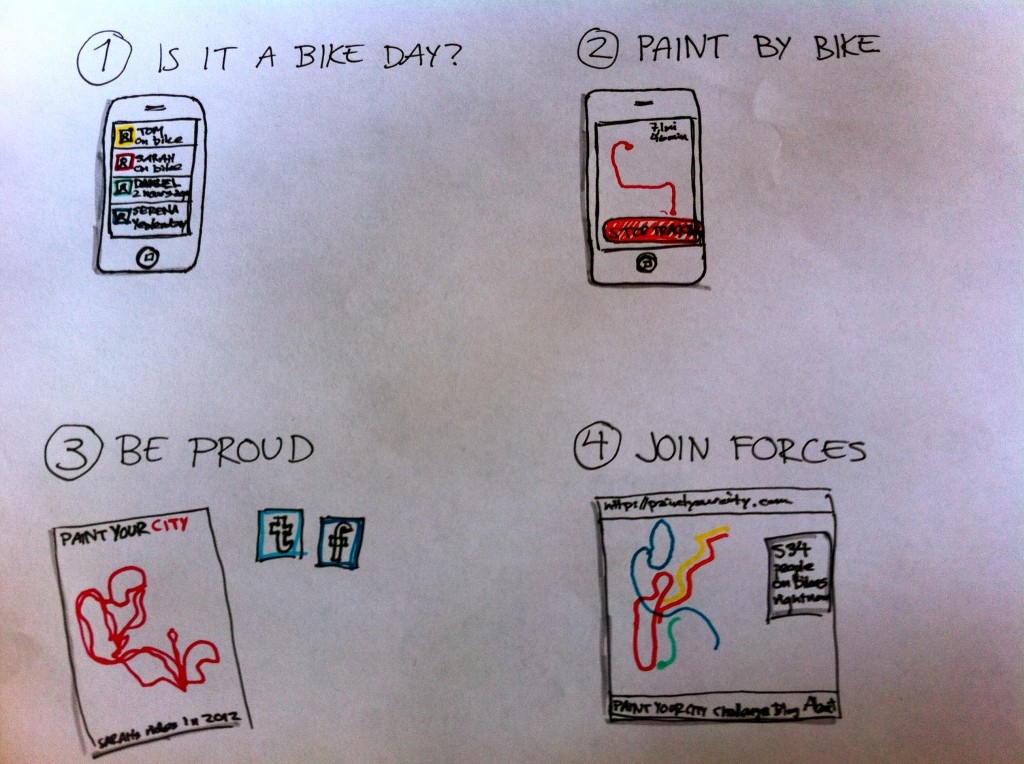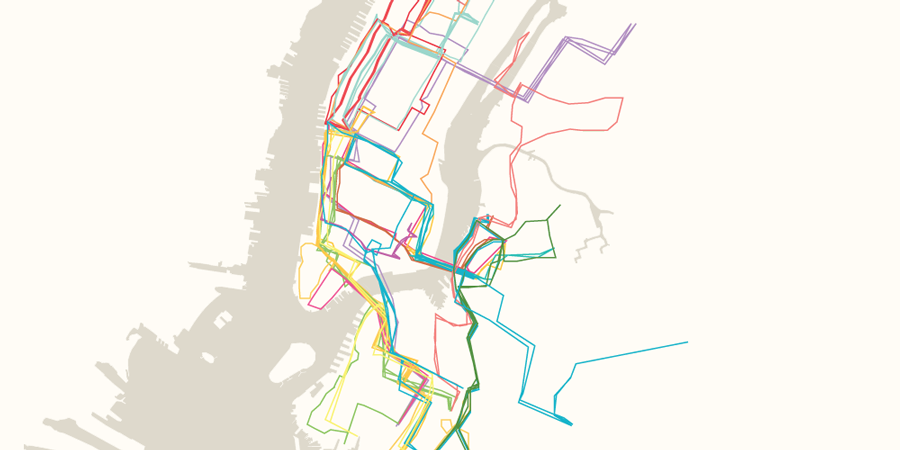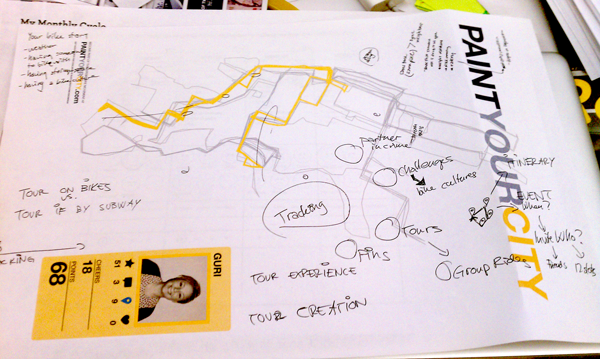After having a look at the brands that our target audience uses, we’ve decided on some traits that we want to embody:
Target Audience
We took a good look at all the wonderful #BikeNYC portraits by Dmitry Gudkov. Then we tried to guess who is likely to use our product. This is plainly based on this one small paper version of a portrait photo, silly stereotyping, and us imagining what kind of person this possibly could be. We even made up stories of some in order to place them right on our sliding scale. “Would this person have a smart phone?”, “Does this person even care about tracking?”, “Is this person too hip, too old, too busy, too …?”. It’s far from scientific, but it definitely helped us thinking of who will be key users of the Paint Your City platform.
By the way, this is true for all the photos except one, as we actually met the amazing Julie (blogger and commuter on a Linus) on the Tour de Taco last year. You might notice that we secretly hope she will be painting her city from her bike :) Click on the image below to see all portraits placed on the axis of most to least likely to use our service.
Brand Landscape
Through using Gimmebar, we have collectively captured a bunch of brands that are either competitors, we want to be similar too, or that we believe influence current bikers, potential bikers and so on. We also added some pure visual inspiration. We went after keywords like fitness, tracking, environment, bikes, transportation, social, lifestyle, nostalgia. When laying the cut-outs out on a table, we tried several different axes for structuring. In the end we were happy with the lifestyle vs. fitness axis, but the other yellow stickies became more like their own little islands, than a continuum.
Either way, we agreed that we are definitely closer to the lifestyle than the fitness space, that our brand should be somewhat creative and “designy”. It should be a Vimeo rather than a YouTube. It will appeal to creatives, but not be over the top hipstery, as we do not want to alienate the masses.
Our brand should feel informational (Feltron-style), though our target audience will not be athletes with $10,000 bikes that care about all kinds of very accurate, detailed data about their rides from a fitness perspective (heart rate, cadence etc).
We believe our target audience could be riding quite a lot of different bike types (road bikes, fixies, cruisers), but think that our brand very well could adapt the clean style of the Abici or the Public bikes. We hope to attract even the people that care about the stylish, old-style Pashleys or Gazelles with fancy baskets, leather saddle and all that, but we don’t dare to go in a too romantic, nostalgic direction with the brand.
Finally, we are flirting with the idea of an open source platform, which in itself will inform how the brand is perceived and how it appeals to more “geeky” audiences. We have not reached a decision on this yet, as we’re still researching various ways to go about when building the platform.
Processing.js is Easy!
Processing.js converts a regular .pde processing file into a JavaScript file to run in the browser. It’s amazing! Below is a quick intro and the setup code from MozillaWiki.
Our Bike Manifesto
HUMAN SUPERPOWERS
Once upon a time, far from now, bicycles were a novelty. Claimed as a gift of science to man, these human-powered machines charmed the adventurous. At the turn of the 20th century, men strapped on their suits and women pulled up their bloomers to ride. These vehicles transformed one’s puny strength into something greater—mankind finally found its’ superpowers, and women in particular found their freedom machines. The bicycle saddle became a lot of people’s primary seat for getting from the suburbs to the inner city to do work.
SOMETHING HAS BEEN LOST
Today, for some people riding a bike from the suburb to the city center is plain out impossible. Today, American cities are built for the automobile. The concrete streets and interstates that link neighborhoods have, in many cases, caused unsustainable and lousy living. Today, we are so much ingrained in the car culture; it’s hard to imagine having it any other way.
NYC IS DIFFERENT
Thank goodness, New York City is different. New Yorkers heavily rely on public transportation and their own two feet to get around. Thanks to the efforts of Janette Sadik-Khan, our city increasingly becomes more bike-able. As Commissioner of the Department of Transportation, she has been painting New York with beautiful green bike lanes since 2007.
PAINT YOUR CITY
We are determined to help Sadik-Khan paint our city. Well. Not literally with green paint all over our hands. However, we are head over heels dedicated to get more people riding on the streets. Instead of using paint, we are giving New Yorkers a color to track their rides on a map. Seeing your own bike rides on a map reveals your bike habits. Seeing your friends bike rides on that map, makes you want to beat them. Or join them. You decide. Either way, you’ll be surprised by how far you can go, as well as inspired by all the places you have yet to conquer.
EXCUSES, EXCUSES…
We’ve heard all the excuses. Seriously, all of them:
“I don’t want to give up my morning bagel routine.”
“I have to wear a suit to work.”
“I don’t want to mess up my hair.”
“It’s so much effort to pack gear everyday.”
“I don’t have room in my apartment for a bike.”
“My bike is so nice, I don’t want it to get stolen in the city.”
“Manhattan terrifies me!”
Honestly, we don’t disagree with any of them. Getting in to the habit of biking is hard at first. We know, we’ve been there.
WE HAVE A SECRET
“Can I really do this?” This was the question we first asked ourselves. We were open to it, curious and felt a little challenged by it. Or a lot. It is this very curiosity that will lead you to discover your human superpowers–just like the men in suits and women in bloomers at the turn of the 20th century. Once you just try it out, we can assure you that you’ll never regret a ride.
A COLOR, A STORY, A VOICE
Your rides have a color, they record your personal story, but they are also a voice in the grander scheme of biking. You and only you own your data. However, by sharing your rides anonymously, you will along with the entire bike community have the power to make New York City more bike-friendly.
Bikeable Cities
I got two books for Christmas. One was about the art of flirting, and it was from my mother. Needless to say, any other book would make me happier. The other book wasn’t just any other, though. It was Bicycle Diaries. Artist and musician David Byrne (from Talking Heads) writes about his love for biking, and how his folding bike has become his favorite way to get around in new cities all over the world.
This point of view–faster than a walk, slower than a train, often slightly higher than a person–became my panoramic window on much of the world over the last thirty years–and it still is.
His descriptions and perspectives on architecture, urban design, politics, culture and art in the cities he visits are all a true joy to read.
Our values and hopes are sometimes awfully embarrassingly easy to read. [...] “This is what we think matters, this is how we live and how we play.” Riding a bike through all this is like navigating the collective neural pathways of some vast global mind.
As a European who was new to the US a couple of years ago, and still haven’t been traveling that much around in this country, it disturbs me to read reports about all these American cities that are planned and laid out as if human beings’ only way of getting around should be by car. In most cities across America it is simply way too dangerous to get from point A to B unless you are within the four walls of a moving vehicle. You actually have to get into a car to visit a different part of town, as different neighborhoods are framed in by freeways.
In most of these cities one could say that the machines have won. [...] I try to explore some of these towns–Dallas, Detroit, Phoenix, Atlanta–by bike, and it’s frustrating. The various parts of town are often “connected”–if one can call it that–mainly by freeways, massive awe-inspiring concrete ribbons that usually kill the neighborhoods they pass through, and often the ones they are supposed to connect as well.
That you are forced into a car to get around is just as true for American suburbia. I remember being in some cute little NJ town with a friend of mine. We were supposed to go to the grocery store to pick up some food for the Sunday dinner.
Me: How far is it?
Him: Only 5 minutes.
Me: So let’s walk then?
Him: Uhm, I meant 5 minutes by car.
Me: But if it’s 5 minutes by car, it surely can’t be more than like a 20 minute walk?
Him: Well, there’s no way to get there on foot. We have to cross this highway, so… I wouldn’t do that.
This is so frightening, upsetting and sad. Or as Byrne says, “it’s long-term unsustainable and short-term lousy living.” Somebody please do something! I’m unfortunately too busy getting together this Paint Your City thesis celebration of biking right now. In the meantime, I’m so grateful that NYC Department of Transportation acknowledges walkers and bikers as well as cars in their transportation plans. Thanks to DOT and Transportation Alternatives, it gets easier and easier to get around by bike. There are more bike commuters than ever, and only the recent snowfall is making my daily bike rides less likely to happen. But for a delicious Sunday brunch, I can do anything!
Is it a bike day?
IS IT A BIKE DAY?
Know the very moment that your friends get on their bikes. If your friends are doing it, obviously you can. Prove it. Skip the morning bagel. Try something new. Be the first one to be on your bike.
PAINT BY BIKE
Track your rides with your phone to color your city with beautiful patterns.
BE PROUD
Be encouraged by your own bike efforts and compare with your friends. Make them jealous for that matter. Go ahead, show off. Tweet, share, like on Facebook. Tell everyone! We’ll even help you print a poster to hang on your wall!
JOIN FORCES
Share your data anonymously and help paint the whole picture of what is happening on NYC streets.
BE INSPIRED
Try new places, new streets, new things on your bike!
About the Project, v.2
Paint Your City is a social tracking platform with game challenges that motivates people to ride their bikes. It’s for city dwellers with under-utilized bikes who have a need to maintain a busy and active lifestyle and get around their city. Spoked values the sheer joy of biking rather than speed, calories, or saving the environment; although, we can’t deny these effects.
Through the service, members choose a color to paint their city and track the rides they take. These rides, which become one’s personal drawing of a city, are beautifully visualized on a communal map where they can be compared with friends.
In addition to this very visual feedback of tracking, Paint Your City will host social challenges that give people a fun and social excuse to either start biking, or to push them to explore more of their city on two wheels. These challenges are designed to happen within a physical workplace, between friends and for members across the entire platform.
Paint Your City will cultivate a bike culture in cities, because it’s simply the best way to get around. It will launch in New York, and could even become part of the bike share system arriving this spring.
Archive Ideas, Begin New
Throughout the months, our thesis project has expanded and contracted with ideas; mainly expanded. Though, our challenge all along has been to get more people biking. A break and space away from it has, thankfully, brought us clarity.
As explained in our initial project description written in September (2011), the concept was once very focused on a physical bike helmet embedded speakers, buttons, sensors and a microphone:
Our project addresses the needs of urban pedalers. New Yorkers bike in chaotic environments. We want to make riders’ trips more seamless while giving them tools to delightfully experience and discover New York from their bike seat and with friends. We’re making a digital toolset embodied in a physical bike helmet. It will provide spoken directions, track riding habits and help riders document trips and arrange rides with friends. Unlike a high-tech GPS bike computer, it will have a charming personality and be designed for the casual and committed commuters.
An endeavor that is part of the SVA IxD thesis program, we hope to create your bike’s better half.
The project continued to involve the helmet throughout the entire semester. But, in October (2011), we decided to design a game, called King of Two Wheels, to explore our concepts around motivation, wayfinding, tracking, and discovery within a city. Hosting this game throughout a week in our studio got us more interested in the shared work environment as the focus for intervention. We iterated further on this idea through developing office game kits, and digital communal maps to be projected on the office wall.
At the end of last semester, the project was filled with opportunities and features—from receiving spoken directions and bookmarking places during a ride to competing for miles and new places with fellow workers. Then, we each took a very deep breath and a three week break to our respective homes, Oslo and Missouri/Texas.
We returned to New York and realized that, rather than adding capabilities to the bike ride itself, the project should focus on how to motivate people while they are not on their bike seat. We believe and have seen the power of data tracking on a communal map, and will leverage this idea as the core of the project. It’s called Paint Your City.
Ridership Statistics
The Department of Transportation has gathered some interesting stats on New Yorkers’ bike habits. The Commuter Cycling Indicator shows a 8% increase between 2010 and 2011, and that commuter cycling more than doubled from 2007 to 2011, in just 4 years. Check out more interesting stats on ridership, and how it has developed at the different typical commuter locations (the bridges, the Hudson River Greenway etc) in this pdf: NYC Commuter Cycling Indicator.


